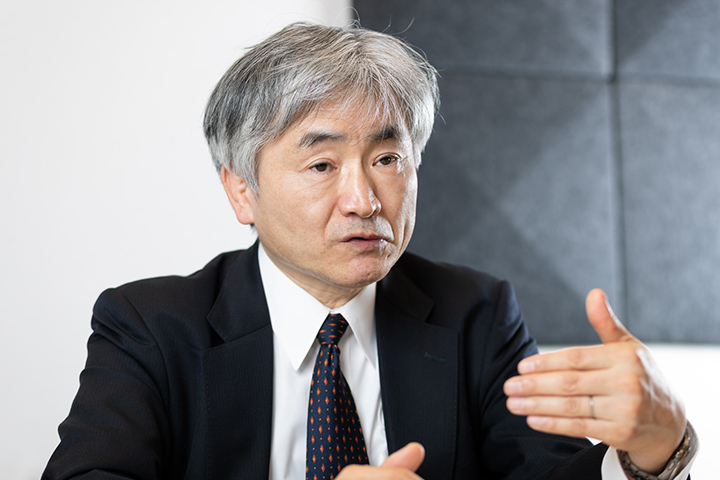Acting for Sustainability : A Legal Perspective
Feature #8: Thinking Through the Trends in Carbon Credits with Mr. Hongo of Mitsui & Co. Global Strategic Studies Institute
(Interview with Takashi Hongo, Senior Fellow, Global Economic & Political Studies Division, Mitsui & Co. Global Strategic Studies Institute, conducted by Kenji Miyagawa, Special Counsel at AMT)

| Issue | Apr 17, 2024 |
|---|

Lately, global-level issues and the UN’s 17 Sustainable Development Goals (SDGs) that indicate the goals for solving these issues have been drawing more attention. At Anderson Mōri & Tomotsune, we as legal professionals continue to look for ways to contribute to achieving these SDGs. Our lawyers have developed a wealth of SDG-related expertise in their respective fields and have put these resources at the disposal of our clients, helping them find best practice-based solutions to the many legal issues that attach to sustainable development.
In this special feature, we introduce some of the activities that have allowed our lawyers not only to commit our Firm to the UN’s SDGs, but also to position our Firm as a leader in the field of sustainability law.
In this feature, we interview Takashi Hongo, Senior Fellow, Global Economic & Political Studies Division, Mitsui & Co. Global Strategic Studies Institute.
*Date of the interview: December 23, 2022, conducted online.
Feature #8: Thinking Through the Trends in Carbon Credits with Mr. Hongo of Mitsui & Co. Global Strategic Studies Institute
(Interview with Takashi Hongo, Senior Fellow, Global Economic & Political Studies Division, Mitsui & Co. Global Strategic Studies Institute, conducted by Kenji Miyagawa, Special Counsel at AMT)
Table of Contents:
Q1:Introduction
MiyagawaThank you for your time today. First of all, could you introduce your current job?
Mr. HongoThank you. I work for Mitsui & Co. Global Strategic Studies Institute. My primary responsibility is to provide advice and information on long-term strategies for so-called sustainability to MITSUI & CO., LTD., owner of our institute.
I am mainly in charge of the environment, climate change, and energy. Among these, I am now particularly focusing on emissions trading. As for technology, I am also focusing on Carbon Capture and Storage, the so-called CCS.
Beyond individual areas, I am also concentrating my efforts on corporate risk management. I am addressing the issue of how we should develop a comprehensive long-term strategy, including risk management on how to respond to business challenges such as climate change constraints, CO2 reduction, and weather-related disasters, as well as the creation of business opportunities.
MiyagawaYou are also playing an important role in external research groups.
Mr. HongoYes, I am involved in a wide range of external research and study groups. Domestically, I participate in the government's studies on climate change, energy, and science and technology, including the use of satellite technology. As for international activities, I have been a board member of the International Emissions Trading Association for about 10 years. I also work on the International Civil Aviation Organization's task force to reduce international aviation emissions.
Q2:Necessity of GX
MiyagawaToday, I would like to hear your thoughts from the perspective of emissions trading or carbon credits.
The necessity of Green Transformation (“GX”) is being discussed at the GX Implementation Council and other fora right now, but on the other hand, energy supply shortages are occurring due to difficult international situations such as the invasion of Ukraine. Under these circumstances, how should Japanese companies deal with GX?
Mr. HongoTo state my conclusion first, I think GX is necessary. I believe many companies and many people has the same views.
However, because there are people suffering from the current energy crisis, I think that you will get the priorities wrong to ignore this situation and implement only GX as a long-term measure. The purpose of GX is to achieve the long-term goal of solving climate change and global issues, so I believe that it is critical to strike a balance between immediate and long-term issues.
MiyagawaIt seems difficult to strike a balance.
Mr. HongoYes, it is easier said than done. There is a trade-off relationship whereby if one is achieved, the other is not, and there is no uniform way to strike a balance, so each country and each company must think and decide on their own what they will prioritize. Japan, as one of the countries in the world, has its own characteristics and a different structure from Europe and the United States. Each industry has a different circumstances. The trade-off between the energy crisis and global challenges is a very critical issue. So, providing multiple options is one way to slightly mitigate this trade-off relationship. It means that the options we have been overlooking may actually be important.
In this respect, Germany’s experience is an interesting case. In the 2010s, Germany announced that it would stop using coal-fired and nuclear power. However, the country heavily relies on imports of natural gas from Russia, so when those imports of natural gas from Russia are cut off due to the invasion of Ukraine and the subsequent sanctions, it would be unable to fulfill its domestic demand for energy. Of course, it will purchase LNG (liquefied natural gas) from countries other than Russia, and energy conservation and renewable energy will accelerate, but it is clear from the calculations that they will still be short of power. Therefore, it has restarted the coal-fired power plants that had been shut down and used its local coal. In addition, it also decided to extend the period of operation of nuclear power plants in anticipation of the possibility of a prolonged energy crisis. Under the previous conditions, it could have managed without these options, but due to changes in the external environment, it could not solve the problem with the options it had, so it restored its other options. Germany has taken a very practical approach.
In the case of GX that Japan is promoting, we must consider a wider range of options in the face of an energy crisis.

Q3:Use of carbon credits
MiyagawaThis discussion, I believe, is leading to the policy mix. The “Carbon Credit Report” released by the Ministry of Economy, Trade and Industry in June 2022 adopts a so-called hierarchy approach. The hierarchy approach aims at reducing greenhouse gas emissions through individual actions, such as promoting energy conservation, but the “Carbon Credit Report” also recommends the use of carbon credits. What is the relationship between this hierarchy approach and the use of carbon credits?
Mr. HongoI proposed the hierarchy approach at the first meeting of the Ministry of Economy, Trade and Industry. When considering what is required to achieve net-zero emissions, it is quite difficult to achieve this without offset by credits. However, as there are various opinions about the use of credits, we have to make sure that everyone can discuss them on a common ground. So I proposed the hierarchy approach. This method is to apply the basic approach towards environmental issues to climate change issues too. This basic approach is to first conserve energy, then switch to low-carbon energy, and then offset the remainder by credits. That is, the order is to first conserve energy, second is to switch energy, and third is to use credits.
With regard to energy conservation, which is the most important point of this hierarchy approach, the EU’s policy deserves strong attention recently concerning energy conservation. As Russian natural gas will no longer be available, the EU has announced various policies, including the search for alternative natural gas sources, say LNG, but what it emphasizes first and foremost is energy conservation. Until now, the EU has rather claimed that global problems could be solved by expanding renewable energy and has been aiming to expand and balance energy, but this has proven to be difficult from a practical point of view. Renewable energy cannot be increased indefinitely, and it takes time to increase it. I think that because such realities became apparent, the importance of energy conservation was recognized in the EU. In addition, the “10-Point Plan to Cut Oil Use” of the IEA (International Energy Agency) also promotes energy conservation.
MiyagawaSo, we should think about energy conservation first, and then about credits.
Mr. HongoYes, it has become clear that even with the efforts to conserve energy and to adopt renewable energy, residual emissions, that is, emissions that cannot be reduced, still remain. To reduce these emissions by using credits is, to put it in a conventional way, the last resort or the last means of offsetting residual emissions.
However, if you carefully think about emissions that cannot be reduced, it is quite complex to define this phenomenon. There are, of course, emissions that cannot be reduced technically in any way, but there are also emissions that can be reduced technically, but which would take 10 or 20 years to do so. There are also cases where technology is available but extremely expensive and not economically feasible. Furthermore, there are cases where technology is available and to some extent feasible in terms of cost, but which have other adverse effects need to be taken into account. For example, in the case of biofuels, even if the cost of biofuels can be reduced, the use of extensive land to supply biofuels will adversely affect agricultural production and local biodiversity. From this example, it can be understood that there are various reasons why emissions cannot be reduced.
If all of these factors are comprehensively considered, carbon offsetting by using credits could be regarded as a practical approach.
MiyagawaI see. Then, in what cases is it advisable to offset as credits the emissions that cannot be reduced?
Mr. HongoThere is some controversy on that point. For example, there is an idea that only removal or negative emissions credits should be used, assuming a net-zero society. There is also an idea that if we reduce emissions today more than yesterday, that is also an effective reduction, so we can use credits for energy conservation in the same sense as borrowing emissions reduction from other companies which reduce more emission than other companies.
In other words, there is a range of choices in the hierarchy approach in terms of under what conditions one should use credits when the emissions cannot be reduced, and in terms of what type of credits one should use to offset the emissions. The hierarchy approach is like a principle of emission reduction, so we have a basic philosophy, but we need to organize our thoughts on how to apply this in practice.
A company may want guidelines that it can refer to, but there is no right answer. A company must think for itself, and if it does not want to use credits, it need not do so.
Carbon offsetting by using credits, similar to the gains from trade and the merits of a division of labor, is an extremely rational approach from an economic point of view. It depends on the company’s strategy on how it should use the credits. It is not a matter of forcing them to use them, nor preventing them from using them. I believe that the correct way to use credits is to allow the company to decide for itself based on the company’s philosophy and international practices.
Q4:How to trade in carbon credits
MiyagawaThank you very much. When utilizing carbon credits, Japanese companies can hold various positions, such as on the supply side of credits, on the demand side, or as intermediaries. From what position should companies trade in carbon credits?
Mr. HongoThe first difficulty with credits is that, unlike energy and food, there is no inherent demand. The demand and supply of credits are only created by regulations and external pressures. Therefore, when companies trade in credits, they should acknowledge the purpose of trading in credits as a premise, such as whether the purpose is to respond to regulations, or whether it will be used as a voluntary initiative after clearing all the regulations. And if they are on the credit supplier side, then they must think about the demand side. They need to confirm who wants them and what they want. I feel that many companies trade in credits without clarifying these points, and that some seem to be confused.
MiyagawaI see. How do you view carbon credit trading?
Mr. HongoTo make credit trading into a business would mean, so to speak, to become a service provider. Previously, there was no significant commercial benefit in reducing CO2 emissions. From now on, however, if we reduce CO2 emissions according to certain rules, we can earn additional income by using credits. This is an innovative and remarkable business. We should make the most of it by studying the rules.
For a new business like this, the system will change rapidly over time. While it is critical for companies to make an upfront investment to take the upside, they must also acknowledge that various changes may occur and must proceed by taking into account political risks.
By the way, although carbon credits are a new business opportunity, if you want to sell credits, it is important to use them yourself first. Regulations for new initiatives are often difficult to understand and there are many things that you cannot understand until you try using them. Therefore, companies will face challenges and discover interesting applications by using credits themselves. For example, a company that says it can provide credits to others may actually be emitting significant amounts of CO2 itself, and its person in charge of credit sales may not be aware of that. Even companies that are reducing CO2 emissions through energy conservation and renewable energy in various projects are naturally emitting CO2 themselves, so I think that it is not a bad idea for a company to grasp its own situation first and then experience using credits itself.

Q5:Carbon credit market
MiyagawaThe Tokyo Stock Exchange has started an experimental operation of a carbon credit market. Why do you think it is necessary to create a carbon credit market in which not only Japanese companies but also foreign companies can participate easily?
Mr. HongoI think the first thing that we have to do is to create a common understanding that foreign companies’ participation also benefits Japan. I understand that there may be concerns about the disadvantages, but we cannot proceed without this basic understanding.
And language can still be a barrier. It is true that there are automatic translation software and other tools, but we cannot rely on only translation software to conduct actual transactions. If we find it beneficial to work with foreign companies, we need to increase the opportunities to explain rules and regulations of GX ETS and other mechanism in English as much as possible. Then, we will all work together to create rules that make it easier for foreign companies to enter the market.
In Japan, we often say that the EU system is impressive, the US system is incredible, and Japan is falling behind. Of course, policy harmonization and institutional collaboration are important, but the situation in each country is different. For example, in Europe, the electricity market has been liberalized, and many companies are entering the market and trading electricity on a daily basis, so the situation is completely different from that in Japan. In other words, I think it is necessary to properly respect each system while taking into account the differences in the foundations, industrial structure, energy structure, and other structures upon which each system is built. The Japanese government will set out a policy of welcoming foreign company collaboration, which Japanese companies should also welcome, so I think that it will be important to foster a collaborative environment.
MiyagawaFrom the viewpoint of increasing the formation and supply of credits, what kind of cooperative relationship is desirable between foreign companies and Japanese companies?
Mr. HongoIn an international business, there are usually collaboration by international players and local players, and local players are very important in running the actual business. This is because it may be higher risk if you do not know the local situation. For example, forests and nature-based solutions do not work unless you are very familiar with the local life, people, and religion. A best international practice often does not work locally. Even if we create internationally acceptable practices to avoid double standards, we still cannot ignore the local situation. From a legal perspective, it is essential to have a good understanding of local laws and regulations.
It is critical to move forward by changing the balance or portfolio between international players who are familiar with international rules and local players who are familiar with the local situation, depending on the business. I think the relationship between foreign companies and Japanese companies in the carbon credit market is the same.
Q6:Greenwashing
MiyagawaBy the way, some people criticize carbon credits as greenwashing, that is, an environmentally friendly disguise for continuing to do business as usual. What do you think about greenwashing?
Mr. HongoIt is a crucial point for risk management. However, in my personal opinion, I have always thought that we need to clarify what constitutes greenwashing before thinking further about its countermeasures. Surprisingly, the contents of greenwashing are not clear.
First, it is a good idea to ask people who use the term greenwashing what they mean by this term. This is because once the contents are organized, it is easier to deal with them. This also applies to those who review the criticism of greenwashing as a risk. First, we need to set out the elements of this term properly. Then we can investigate it This order is important because we can assume measures only after we know the cause.
It may turn out that the definition of greenwashing given by some is based on misunderstandings. Also, the differences in the premises used for discussion and subjective views may be the reason that greenwashing has various definitions. With that in mind, companies must explain the facts, which explanation must be more than sufficient. And there is always the possibility of push-back in many cases, especially when dealing with environmental issues. Anything that we do will result in a burden on the environment, and whether that environmental burden is within the acceptable range in light of systems and social practices can become a point of discussion. In such cases, companies need to examine the facts and provide detailed explanations, such as “There is a risk of XXX in regard to XXX, and we are therefore taking measures to XXX. Therefore, although our action creates a burden on the environment, there are social and economic benefits that exceed these burdens.” It is troublesome to review this for each small business in detail, but I think that it is beneficial to scrutinize the company’s views in detail.
Even if you explain your views carefully, you will still receive various opinions. Taking the most recent World Cup in soccer, for example, some say that this was the best World Cup in history, while others say that this was the worst. To respond to such divisions of opinion, companies should explain that “this is what we think”, and discuss the issue if necessary, even if this takes time and effort. I think this is important in the long term in terms of establishing and maintaining the reputation of the company
Q7:Summary
MiyagawaFinally, are there any points that companies should be aware of when integrating GX into their growth strategy?
Mr. HongoWhen companies analyze their cash flow and review the profitability of their business, some businesses conduct a sensitivity analysis, which takes into account changes in their external environment. In this regard, we should note that, in the case of climate change issues, there can be significant changes. For example, CO2 can be included in a cash flow analysis if it is expressed in the form of a carbon price, but the carbon price may change significantly as an external factor. In a scenario analysis, as we need to consider changes in the market and other factors, it is important to consider changes in the external environment and conduct a thorough analysis, and I think the question of how to look at trends in carbon prices is a key point in the analysis.
By the way, in a scenario analysis, it is a big burden to consider scenarios by yourself, so you may want to commission a third party to do it, but it is better to resist such an impulse. There are various approaches to scenario analysis, speaking of climate change, such as the IEA balanced approach, which is becoming a standard, the Nordic approach, which focuses on hydrogen, and the NGO approach, which can be easily implemented with 100% renewable energy. If you study these carefully, you will find that they do not differ in their models, but in their assumptions. The difference in assumptions leads to completely different results. It is important for companies to learn accurately of the differences between these approaches and to discuss the assumptions used by each approach, by considering whether they are realistic. Through discussions, companies can gain knowledge and experience, and by comparing various scenarios, they can create a long-term outlook for their business.
Another thing to remember is that even if you create a scenario, there are always upturns and downturns. A sensitivity analysis of the upturns and downturns in scenarios is necessary, and a portfolio approach is also important for companies that are engaged in multiple businesses. You should think, “This is our core scenario but there are many other possible patterns, such as when climate change measures progress further or are delayed slightly.” As a result, I believe that a portfolio approach that can respond to both upturns and downturns from the assumed scenario is becoming more important in corporate strategy management. From this perspective, there is no major difference between an ordinary business analysis and a management strategy that focuses on GX.
MiyagawaI see that proper analysis is necessary when working on carbon credits and GX. Thank you very much for your time today.

Senior Fellow, Global Economic & Political Studies Division
Mitsui & Co. Global Strategic Studies Institute
Since 2011, he has worked for Mitsui & Co. Global Strategic Studies Institute. In 1981, he joined the Export-Import Bank of Japan (current Japan Bank for International Cooperation). He held posts such as Special Advisor to Governor, Head of Environment Finance Engineering Department at the bank. He was seconded to the former Economic Planning Agency and the former Industrial Bank of Japan.
He is a member of Board of Directors for International Emission Trading Association, ICAO CORSIA Task Force, ISO TC 207 (Carbon Neutrality), and ISO TC 265 (CCS), etc. He is also a member of numerous committees and research groups, including the Science and Technology Committee for Environment and Energy of the Ministry of Education, Culture, Sports, Science and Technology, the Committee for Confirmation of CO2 emission reduction of CO2 Reduction Program of the Ministry of the Environment, and Technology Evaluation Committee of NEDO. Recently, he has been involved in committees for Carbon Credit Report for GX ETS, Private driven JCM, Forest Credit Subcommittee for J Credits, and CCS Roadmap, etc. His column has been published in Earth New Stream of the Nikkei Business Daily (since 2011 to February 2024). He is a lecturer, Faculty of Economics, Dokkyo University.
Lectures and writings
UN Climate Change Conferences, Carbon EXPO, ICAO, GLOBE International, Singapore International Water Week (SIWW), Global Water Summit, etc. Moderator for a number of events. Witness of International Committee on Global Environment and Food of the House of Councilors. “Game Change to a Low-Carbon Society” (Nikkei e Shinsho), Reform of Finance toward Green Growth in Asia, Road to Market Mechanism for Sustainable Use of Biodiversity, Circular Economy Potential and Public Private Partnership Model in Japan, Prospects of Quality Infrastructure and Private Sector MRV for Accelerating the Transition Toward Low Carbon, Energy Innovation of Finance for Industry 4.0 in ASEAN, Carbon Pricing to Promote Green Energy Projects, etc.






